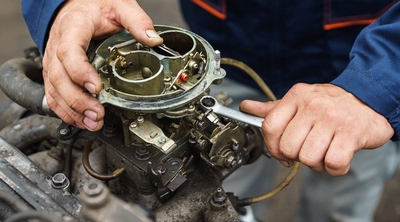How to check car oil, brake, and power steering fluid
2 min read
Your car is a big investment, so you must maintain it to keep it running at its peak performance. That’s why it’s important to periodically check the fluid levels of the juices that keep it moving safely, such as the oil, brake, and power steering fluids. Let’s take a closer look under the hood.
How to check oil levels
The first thing to do when checking car oil is to ensure the engine is off. The ideal time to check your oil levels is when the engine is slightly warm, like after a quick ride to the post office or store. Once you’ve securely propped the hood open, find the dipstick. You’ll usually find it on the left side of the engine. Pull the dipstick out, wipe off any oil with a rag, then reinsert it, ensuring it goes all the way in. Next, pull it out again and look where the oil appears on the stick. There will be markings to indicate the appropriate and safe level. If it falls below the minimum, it’s time to add oil.
It’s important to get regular oil changes as this is one of the essential things to maintain your car properly. Not only will it extend the life of the engine, but it will also provide a smoother ride and better gas mileage. Failure to keep up with oil changes can damage other essential engine components.
How to check brake fluid levels
When checking brake fluid levels, look for the brake cylinder reservoir, which you might find toward the rear of the engine compartment. It’s usually a plastic cylinder that’s easy to spot. Unscrew the top carefully, ensuring no debris or dirt gets into the reservoir. And keep in mind that brake fluid is sensitive to outside moisture and elements and can lose its effectiveness quickly if left exposed. Check that the fluid is at the proper level. There will usually be “min” and “max” markings. If it’s not, add brake fluid designed for your make and model. Refer to your owner’s manual if you’re unsure. Then screw the cap back on securely.
Here’s a tip to keep in mind when checking brake fluid: never let brake fluid drip onto your car’s paint. It is corrosive and will damage the finish.
How to check power steering fluid levels
Most drivers don’t think of checking power steering fluid levels like they do their oil. But it’s easy to do, so why not check it every time you check your oil? Many vehicles have a marked black cap with a white or yellow cylinder for the power steering fluid. If yours doesn’t, refer to your owner’s manual to locate it. Some reservoirs are see-through, and others may have a dipstick.
As with checking your car oil, ensure the fluid level falls between the “min” and “max” ranges. Even if the levels look good, also check the fluid’s color. It should have an amber hue. If it’s brown or black, the system will need to be flushed, and new fluid added. Learn more about power steering fluid and how to check other essential car fluid levels.
What should I do if I see fluid leaking?
If you spot a puddle forming under your car, you need to know where the leak is coming from and what fluid is leaking. The color of the fluid is often a good indicator. A water leak is obvious, but it can sometimes be hard to distinguish oil from transmission or power steering fluid. Learn more about what to do if your car leaks.




